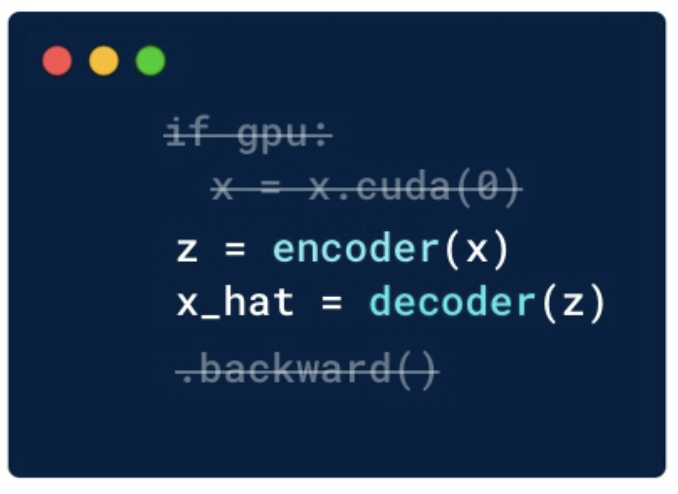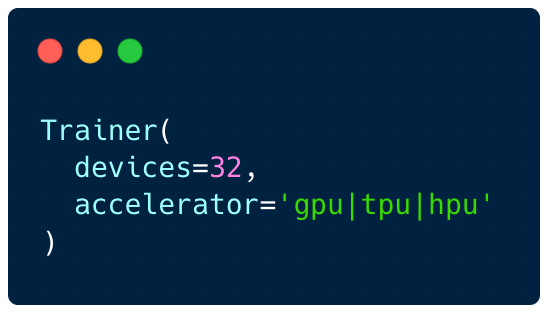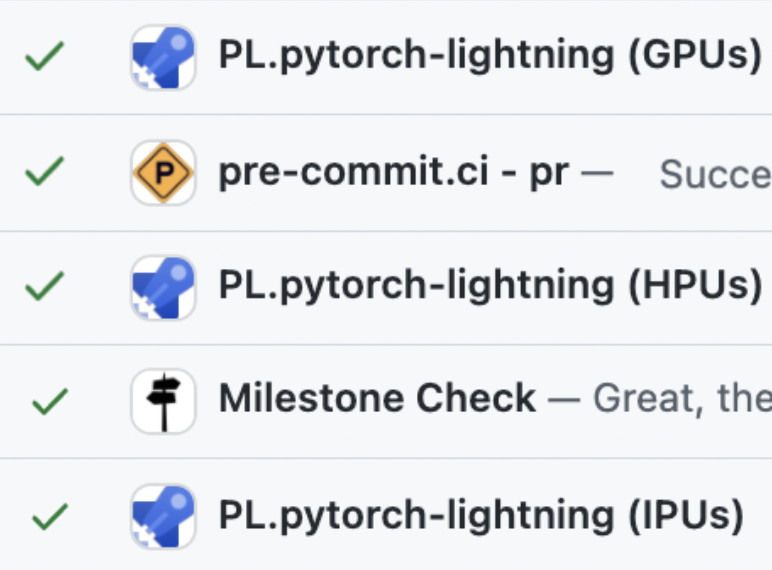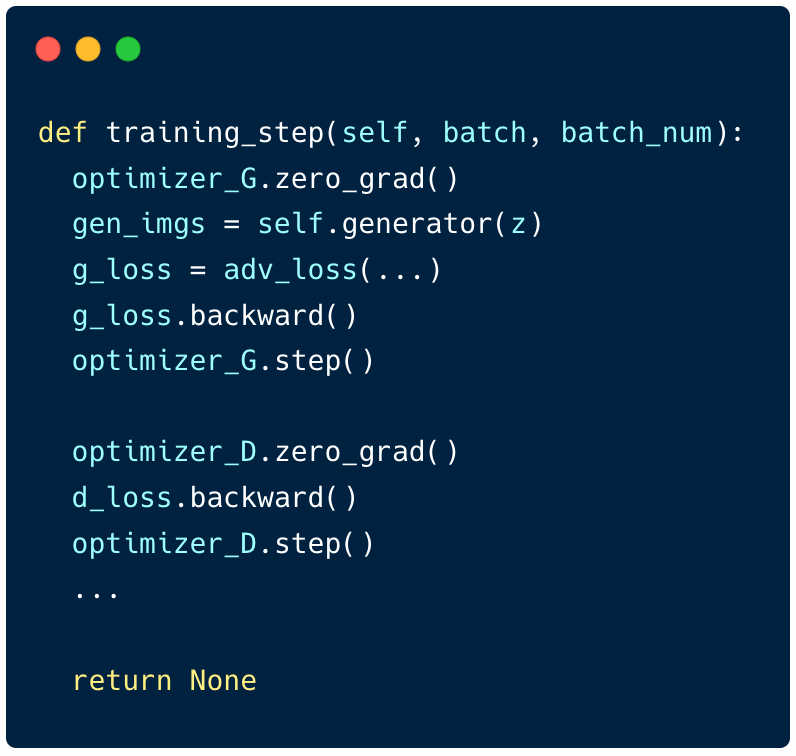Lightning in 15 minutes¶
Required background: None
Goal: In this guide, we’ll walk you through the 7 key steps of a typical Lightning workflow.
PyTorch Lightning is the deep learning framework with “batteries included” for professional AI researchers and machine learning engineers who need maximal flexibility while super-charging performance at scale.
Lightning organizes PyTorch code to remove boilerplate and unlock scalability.
By organizing PyTorch code, lightning enables:

Full flexibility
Try any ideas using raw PyTorch without the boilerplate.

Reproducible + Readable
Decoupled research and engineering code enable reproducibility and better readability.

Simple multi-GPU training
Use multiple GPUs/TPUs/HPUs etc... without code changes.

Built-in testing
We've done all the testing so you don't have to.
1: Install PyTorch Lightning¶
Or read the advanced install guide
2: Define a LightningModule¶
A LightningModule enables your PyTorch nn.Module to play together in complex ways inside the training_step (there is also an optional validation_step and test_step).
import os
from torch import optim, nn, utils, Tensor
from torchvision.datasets import MNIST
from torchvision.transforms import ToTensor
import lightning as L
# define any number of nn.Modules (or use your current ones)
encoder = nn.Sequential(nn.Linear(28 * 28, 64), nn.ReLU(), nn.Linear(64, 3))
decoder = nn.Sequential(nn.Linear(3, 64), nn.ReLU(), nn.Linear(64, 28 * 28))
# define the LightningModule
class LitAutoEncoder(L.LightningModule):
def __init__(self, encoder, decoder):
super().__init__()
self.encoder = encoder
self.decoder = decoder
def training_step(self, batch, batch_idx):
# training_step defines the train loop.
# it is independent of forward
x, _ = batch
x = x.view(x.size(0), -1)
z = self.encoder(x)
x_hat = self.decoder(z)
loss = nn.functional.mse_loss(x_hat, x)
# Logging to TensorBoard (if installed) by default
self.log("train_loss", loss)
return loss
def configure_optimizers(self):
optimizer = optim.Adam(self.parameters(), lr=1e-3)
return optimizer
# init the autoencoder
autoencoder = LitAutoEncoder(encoder, decoder)
3: Define a dataset¶
Lightning supports ANY iterable (DataLoader, numpy, etc…) for the train/val/test/predict splits.
# setup data
dataset = MNIST(os.getcwd(), download=True, transform=ToTensor())
train_loader = utils.data.DataLoader(dataset)
4: Train the model¶
The Lightning Trainer “mixes” any LightningModule with any dataset and abstracts away all the engineering complexity needed for scale.
# train the model (hint: here are some helpful Trainer arguments for rapid idea iteration)
trainer = L.Trainer(limit_train_batches=100, max_epochs=1)
trainer.fit(model=autoencoder, train_dataloaders=train_loader)
The Lightning Trainer automates 40+ tricks including:
Epoch and batch iteration
optimizer.step(),loss.backward(),optimizer.zero_grad()callsCalling of
model.eval(), enabling/disabling grads during evaluationTensorboard (see loggers options)
Multi-GPU support
16-bit precision AMP support
5: Use the model¶
Once you’ve trained the model you can export to onnx, torchscript and put it into production or simply load the weights and run predictions.
# load checkpoint
checkpoint = "./lightning_logs/version_0/checkpoints/epoch=0-step=100.ckpt"
autoencoder = LitAutoEncoder.load_from_checkpoint(checkpoint, encoder=encoder, decoder=decoder)
# choose your trained nn.Module
encoder = autoencoder.encoder
encoder.eval()
# embed 4 fake images!
fake_image_batch = torch.rand(4, 28 * 28, device=autoencoder.device)
embeddings = encoder(fake_image_batch)
print("⚡" * 20, "\nPredictions (4 image embeddings):\n", embeddings, "\n", "⚡" * 20)
6: Visualize training¶
If you have tensorboard installed, you can use it for visualizing experiments.
Run this on your commandline and open your browser to http://localhost:6006/
tensorboard --logdir .
7: Supercharge training¶
Enable advanced training features using Trainer arguments. These are state-of-the-art techniques that are automatically integrated into your training loop without changes to your code.
# train on 4 GPUs
trainer = L.Trainer(
devices=4,
accelerator="gpu",
)
# train 1TB+ parameter models with Deepspeed/fsdp
trainer = L.Trainer(
devices=4,
accelerator="gpu",
strategy="deepspeed_stage_2",
precision=16
)
# 20+ helpful flags for rapid idea iteration
trainer = L.Trainer(
max_epochs=10,
min_epochs=5,
overfit_batches=1
)
# access the latest state of the art techniques
trainer = L.Trainer(callbacks=[WeightAveraging(...)])
Maximize flexibility¶
Lightning’s core guiding principle is to always provide maximal flexibility without ever hiding any of the PyTorch.
Lightning offers 5 added degrees of flexibility depending on your project’s complexity.
Customize training loop¶

Inject custom code anywhere in the Training loop using any of the 20+ methods (Hooks) available in the LightningModule.
class LitAutoEncoder(L.LightningModule):
def backward(self, loss):
loss.backward()
Extend the Trainer¶
If you have multiple lines of code with similar functionalities, you can use callbacks to easily group them together and toggle all of those lines on or off at the same time.
trainer = Trainer(callbacks=[AWSCheckpoints()])
Use a raw PyTorch loop¶
For certain types of work at the bleeding-edge of research, Lightning offers experts full control of optimization or the training loop in various ways.
Next steps¶
Depending on your use case, you might want to check one of these out next.

